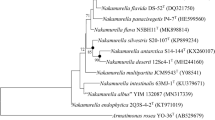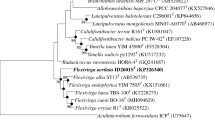Abstract
Strain designated DB0510T was isolated from an automobile evaporator core collected in Korea. Cells are gram-stain-positive, aerobic, and coccoid. The strain grew at 15–45 ℃, pH 5.0–8.5 and 0–8.0% (w/v) NaCl. Growth occurs on R2A, trypticase soy agar, Luria–Bertani agar, and nutrient agar. Phylogenetic analysis showed that the strain belongs to the family Dermacoccaceae and strain DB0510T was distinctly separated from validly named genera of this family. Signature nucleotides in 16S rRNA gene sequence revealed that the strain contained the Dermacoccaceae family-specific 16S rRNA signature nucleotides patterns. The major fatty acids were C17:0 and C17:1 cis-9. The only menaquinone was MK-8 (H4). The polar lipids were phosphatidylglycerol, diphosphatidylglycerol, phosphatidylinositol, phosphatidylinositol mannoside, and two unidentified lipids. The diagnostic cell-wall amino acid at position 3 of the peptide subunit was found to be lysine. The cell-wall peptidoglycan contained alanine, aspartic acid, glutamic acid, glycine, lysine, and serine and thus the peptidoglycan type was concluded to be of A4α type with Lys-Gly-Ser-Asp interpeptide bridge. The genome size was 3.49 Mbp and G + C content of the genome DNA was 69.4 mol%. On the basis of the phenotypic, genomic, and chemotaxonomic characteristics, strain DB0510T is considered to represent a novel genus and species within the family Dermacoccaceae, for which the name Metallococcus carri gen. nov., sp. nov. is proposed. The type strain of Metallococcus carri is DB0510T (= KACC 19663 T = NBRC 113349 T).

Similar content being viewed by others
References
Ai MJ, Sun Y, Sun HM, Liu HY, Yu LY, Zhang YQ (2017) Allobranchiibius huperziae gen. nov., sp. nov., a member of Dermacoccaceae isolated from the root of a medicinal plant Huperzia serrata (Thunb.). Int J Syst Evol Microbiol 67:4210–4215
Ara I, Yamamura H, Tsetseg B, Daram D, Ando K (2010) Luteipulveratus mongoliensis gen. nov., sp. nov., an actinobacterial taxon in the family Dermacoccaceae. Int J Syst Evol Microbiol 60:574–579
Anzai K, Sugiyama T, Sukisaki M, Sakiyama Y, Otoguro M, Ando K (2011) Flexivirga alba gen. nov., sp. nov., an actinobacterial taxon in the family Dermacoccaceae. J Antibiot 64:613–616
Breznak JA, Costilow RN (2007) Physicochemical factors in growth. In: Beveridge TJ, Breznak JA, Marzluf GA, Schmidt TM, Snyder LR (eds) Methods for general and molecular bacteriology. American Society for Microbiology, Washington, pp 309–329
Embley TM, Wait R (1994) Structural lipids of eubacteria. In: Goodfellow M, O’Donnell AG (eds) Modern microbial method: chemical methods in prokaryotic systematics. Wiley, Chichester, pp 121–161
Felsenstein J (1981) Evolutionary trees from DNA sequences: a maximum likelihood approach. J Mol Evol 17:368–376
Felsenstein J (1985) Confidence-limits on phylogenies: an approach using the bootstrap. Evolution 39:783–791
Fitch WM (1971) Toward defining the course of evolution: minimum change for a specific tree topology. Systematic Biol 20:406–416
Groth I, Schumann P, Rainey FA, Martin K, Schuetze B, Augsten K (1997) Demetria terragena gen. nov., sp. nov., a new genus of actinomycetes isolated from compost soil. Int J Syst Evol Microbiol 47:1129–1133
Kim SJ, Jang YH, Ahn JH, Weon HY, Schumann P, Chun SC, Kwon SW, Kim WG (2013) Rudaeicoccus suwonensis gen. nov., sp. nov., an actinobacterium isolated from the epidermal tissue of a root of a Phalaenopsis orchid. Int J Syst Evol Microbiol 63:1291–1296
Kimura M (1980) A simple method for estimating evolutionary rates of base substitutions through comparative studies of nucleotide sequences. J Mol Evol 16:111–120
Komagata K, Suzuki K-I (1987) Lipid and cell-wall analysis in bacterial systematics. Methods Microbiol 19:161–207
Kumar S, Stecher G, Tamura K (2016) MEGA7: Molecular evolutionary genetics analysis version 7.0 for bigger datasets. Mol Biol Evol 33:1870–1874
Lee LH, Cheah YK, Sidik SM, Wie QY, Tang YL, Lin HP, Mutalib NSA, Kui H (2013) Barrientosiimonas humi gen. nov., sp. nov., an actinobacterium of the family Dermacoccaceae. Int J Syst Evol Microbiol 63:241–248
Lee H, Kim DU, Lee S, Sg K, Park AY, Ahn JH, Ka JO (2019) Flavisolibacter aluminii sp. nov., a novel member of the genus Flavisolibacter isolated from an automotive air conditioning system. J Microbiol 57:18–22
Lee SD, Kim IS, Schumann P, Song G (2020) Leekyejoonella antrihumi gen. nov., sp. nov., a new member of the family Dermacoccaceae isolated from a cave soil. Int J Syst Evol Microbiol 70:3340–3347
Minnikin DE, O’Donnell AG, Goodfellow M, Alderson G, Athalye M, Schaal A, Parlett J (1984) An integrated procedure for the extraction of bacterial isoprenoid quinones and polar lipids. J Microbiol Methods 2:233–241
Pruesse E, Peplies J, Glockner FO (2012) SINA: accurate high-throughput multiple sequence alignment of ribosomal RNA genes. Bioinformatics 28:1823–1829
Ruckmani A, Kaur I, Schumann P, Klenk HP, Mayilraj S (2011) Calidifontibacter indicus gen. nov., sp. nov., a member of the family Dermacoccaceae isolated from a hot spring, and emended description of the family Dermacoccaceae. Int J Syst Evol Microbiol 61:2419–2424
Saitou N, Nei M (1987) The neighbor-joining method: a new method for reconstructing phylogenetic trees. Mol Biol Evol 4:406–425
Sasser M (1990) Identification of bacteria by gas chromatography of cellular fatty acids. MIDI technical note 101. Microbial ID, Inc, Newark
Schleifer KH, Kandler O (1972) Peptidoglycan types of bacterial cell walls and their taxonomic implications. Bacteriol Rev 36:407–477
Schumann P (2011) Peptidoglycan structure. Methods Microbiol 38:101–129
Smibert RM, Krieg NR (1994) Phenotypic characterization. In: Gerhardt P, Murray RGE, Wood WA, Krieg NR (eds) Methods for general and molecular bacteriology. American society for microbiology, Washington, pp 607–654
Stackebrandt E, Koch C, Gvozdiak O, Schumann P (1995) Taxonomic Dissection of the Genus Micrococcus: Kocuria gen. nov., Nesterenkonia gen. nov., Kytococcus gen. nov., Dermacoccus gen. nov., and Micrococcus Cohn 1872 gen. emend. Int J Syst Evol Microbiol 45:682–692
Stackebrandt E, Schumann P (2000) Description of Bogoriellaceae fam. nov., Dermacoccaceae fam. nov., Rarobacteraceae fam. nov. and Sanguibacteraceae fam. nov. and emendation of some families of the suborder Micrococcineae. Int J Syst Evol Microbiol 50:1279–1285
Sugimoto S, Kato T, Ito M, Sakata N, Tsuchida T, Matsumoto A, Takahashi Y (2011) Branchiibius hedensis gen. nov., sp. nov., an actinobacterium isolated from a Japanese codling (Physiculus japonicus). Int J Syst Evol Microbiol 64(5):1195–1200
Tang SK, Wu JY, Wang Y, Schumann P, Li WJ (2010) Yimella lutea gen. nov., sp. nov., a novel actinobacterium of the family Dermacoccacea. Int J Syst Evol Microbiol 60:659–663
Yoon SH, Ha SM, Kwon S, Lim J, Kim Y, Seo H, Chun J (2017) Introducing EzBioCloud: a taxonomically united database of 16S rRNA and whole genome assemblies. Int J Syst Evol Microbiol 67:1613–1617
Funding
This study was carried out with the support of “Cooperative Research Program for Agriculture Science & Technology Development (Project No. PJ0152432020)”, Rural Development Administration, Republic of Korea.
Author information
Authors and Affiliations
Corresponding author
Ethics declarations
Conflicts of interest
The authors declare that there are no conflicts of interest.
Additional information
Communicated by Erko Stackebrandt.
Publisher's Note
Springer Nature remains neutral with regard to jurisdictional claims in published maps and institutional affiliations.
Supplementary Information
Below is the link to the electronic supplementary material.
Rights and permissions
About this article
Cite this article
Lim, J.S., Lee, H., Son, J. et al. Metallococcus carri gen. nov., sp. nov., a novel member of the family Dermacoccaceae isolated from an automotive air conditioning system. Arch Microbiol 203, 4073–4079 (2021). https://doi.org/10.1007/s00203-021-02386-4
Received:
Revised:
Accepted:
Published:
Issue Date:
DOI: https://doi.org/10.1007/s00203-021-02386-4




